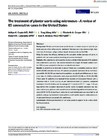| dc.contributor.author | Gupta, Aditya K. | |
| dc.contributor.author | Wang, Tong | |
| dc.contributor.author | Cooper, Elizabeth A. | |
| dc.contributor.author | Conenello, Robert M. | |
| dc.contributor.author | Bristow, Ivan | |
| dc.date.accessioned | 2024-04-18T09:04:54Z | |
| dc.date.available | 2024-04-18T09:04:54Z | |
| dc.date.issued | 2023-06-20 | |
| dc.identifier.citation | Gupta, A. K., Wang, T., Cooper, E. A., Conenello, R. M., & Bristow, I. R. (2023). The treatment of plantar warts using microwave-A review of 85 consecutive cases in the United States. Journal of Cosmetic Dermatology, 22(10), 2729–2736. https://doi.org/10.1111/jocd.15802 | en |
| dc.identifier.issn | 1473-2130 | |
| dc.identifier.uri | https://aecc.archive.knowledgearc.net/handle/123456789/296 | |
| dc.description | Available under License - Creative Commons Attribution: https://creativecommons.org/licenses/by/4.0/ | en |
| dc.description.abstract | Background: Plantar warts (verrucae plantaris) are a common source of pain for patients and are often refractory to treatment. Previous work has shown a high clearance rate of verrucae using a surface-based microwave device (Swift®).
Aims: To assess the efficacy, defined as the complete visible clearance of warts, in patients with verrucae plantaris receiving microwave treatment.
Patients: We undertook a retrospective review and identified records of 85 patients who underwent a course of microwave treatment at a single US-based podiatry centre. Efficacy was analyzed on the basis on intention-to-treat.
Results: In patients who received ≥1 session there was a complete clearance rate of 60.0% (51/85) (intention-to-treat; 59 patients completed treatment, 26 lost to follow-up) and 86.4% (51/59) per treatment completion; no significant differences in clearance rates of children and adults were observed (61.0% [25/41] vs. 59.1% [26/44]). There were 31 patients who received three sessions of microwave therapy with a clearance rate of 71.0% (22/31) as per intention-to-treat (27 patients completed treatment, 4 lost to follow-up). An average of 2.3 sessions (SD: 1.1; range: 1-6) was required for the complete clearance of plantar warts. Complete clearance was also observed in some patients with recalcitrant warts following additional treatment sessions (42.9% [3/7]). A significant reduction in wart related pain was reported for all patients undergoing treatment. Some patients continued to report a reduced amount of pain post-therapy compared with pretherapy.
Conclusions: Microwave treatment of verrucae plantaris appears to be a safe and effective procedure. | en |
| dc.language.iso | en | en |
| dc.publisher | Journal of Cosmetic Dermatology | en |
| dc.subject | HPV | en |
| dc.subject | Foot | en |
| dc.subject | Microwave | en |
| dc.subject | Verruca | en |
| dc.subject | Wart | en |
| dc.title | The treatment of plantar warts using microwave-A review of 85 consecutive cases in the United States | en |
| dc.type | Article | en |
| dc.identifier.doi | https://doi.org/10.1111/jocd.15802 | |
